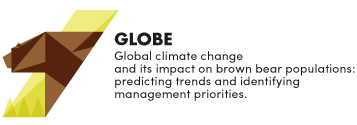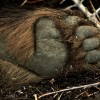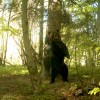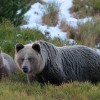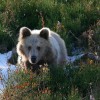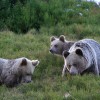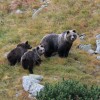 Dr. Marc Cattet is a research associate with the Canadian Wildlife Health Cooperative (CWHC) and an adjunct professor in the Department of Veterinary Pathology at the Western College of Veterinary Medicine in Saskatoon, Canada. He is currently engaged in major studies of environmental health assessment in grizzly bear landscape ecology, of new measures of long-term stress in vertebrates in the context of environmental monitoring, health and impact assessment, and on chemical immobilization and handling of wild animals (https://www.usask.ca/wcvm/wcvm_people/profiles/Cattet_Marc.php). We cooperate within GLOBE project on disentangling brown bear stress ecology within work package 3: “Climate and human-mediated effects on brown bear stress ecology“. He paid us a weeklong visit, during which he gave a lecture on wildlife health issues and worked on our ongoing studies of bear stress
Dr. Marc Cattet is a research associate with the Canadian Wildlife Health Cooperative (CWHC) and an adjunct professor in the Department of Veterinary Pathology at the Western College of Veterinary Medicine in Saskatoon, Canada. He is currently engaged in major studies of environmental health assessment in grizzly bear landscape ecology, of new measures of long-term stress in vertebrates in the context of environmental monitoring, health and impact assessment, and on chemical immobilization and handling of wild animals (https://www.usask.ca/wcvm/wcvm_people/profiles/Cattet_Marc.php). We cooperate within GLOBE project on disentangling brown bear stress ecology within work package 3: “Climate and human-mediated effects on brown bear stress ecology“. He paid us a weeklong visit, during which he gave a lecture on wildlife health issues and worked on our ongoing studies of bear stress
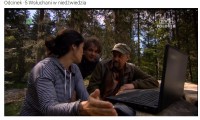 We recommend to all interested in the research on the brown bears a movie from the series "Dancing with Nature" realised by the TVP http://www.tanczacyznatura.tvp.pl/21488540/odcinek-5-wsluchani-w-niedzwiedzia. Nuria Selva, Tomasz Zwijacz-Kozica and Filip Zieba talk about what and how we study in, among others, the GLOBE project.
We recommend to all interested in the research on the brown bears a movie from the series "Dancing with Nature" realised by the TVP http://www.tanczacyznatura.tvp.pl/21488540/odcinek-5-wsluchani-w-niedzwiedzia. Nuria Selva, Tomasz Zwijacz-Kozica and Filip Zieba talk about what and how we study in, among others, the GLOBE project.
"This time "Dancing with Nature" are looking for signs of bears. When hiking in the Tatra you need to keep your eyes wide open. What matters are the scratches on the tree, bones scattered among pines, large animal droppings on a wild meadow, hair left on husky trunk, but also all traces around Zakopane garbage dams and surrounded shelters. At all these diligently look Assoc. prof. Nuria Selva, a bear researcher and Filip Zieba, an employee of the Tatra National Park. They trace Tatra bears with aerial telemetry. When "Dancing with Nature" move into the forest, they find out that bears are often just around the corner, even in the middle of the day, though it can not be seen and heard."
We highly recommend it!
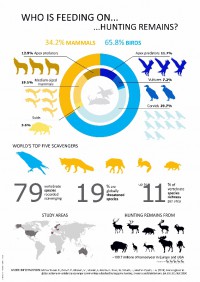 Big game hunting is providing scavengers with large amounts of carrion every year and, thus, affecting ecosystems and animal communities. In Europe, hunters discard about 100 million tonnes of carcasses and remains each year. This paper reviews the vertebrate species consuming carrion derived from this activity across different ecosystems in the world. As much as 79 species use this human-provided food; 19% of which are globally threatened. Fifteen apex predators, including the brown bear, were recorded scavenging on hunting remains. Their consumption is dominated by generalists, like bears, particularly in areas where vultures and specialist apex predators are rare or absent. By feeding on carrion, scavengers support key ecosystem services, such as accelerating nutrient recycling or limiting disease spreading. However, in degraded ecosystems with low diversity of scavenger, these services can be at risk.
Big game hunting is providing scavengers with large amounts of carrion every year and, thus, affecting ecosystems and animal communities. In Europe, hunters discard about 100 million tonnes of carcasses and remains each year. This paper reviews the vertebrate species consuming carrion derived from this activity across different ecosystems in the world. As much as 79 species use this human-provided food; 19% of which are globally threatened. Fifteen apex predators, including the brown bear, were recorded scavenging on hunting remains. Their consumption is dominated by generalists, like bears, particularly in areas where vultures and specialist apex predators are rare or absent. By feeding on carrion, scavengers support key ecosystem services, such as accelerating nutrient recycling or limiting disease spreading. However, in degraded ecosystems with low diversity of scavenger, these services can be at risk.
For more information:
We already know the results of Eryk’s autopsy. Paralyzed animal was found in the Jaworzynka Valley in the Tatra National Park. Unfortunately, to shorten Eryk's suffering doctors decided to put the animal down. Eryk's autopsy was performed by the veterinary doctors of the Department of Epizootiology and Clinic of Bird and Exotic Animals, the Faculty of Veterinary Medicine, Wrocław University of Environmental and Life Sciences.
The bear post-mortem examination revealed that the cause of paralysis was very advanced inflammation, involving the vertebral bodies and intervertebral discs on the section from 2 to 4 thoracic vertebra. Nature of change (taking into account the good condition of the animal, empty digestive tract and the advancement of skin changes around the hind quarters) indicates that the exacerbation of the disease process was 3 to 5 days before finding the animal. The observed pathological changes were irreversible and lead to the total paralysis of all limbs. There was no evidence of parasites of the gastrointestinal tract, or rabies.
In addition, there is evidence of the presence of gunshot bullet in the neck muscles. It was a bullet probably from hunting weapons. Nature of change indicates that the animal was gunshot few months ago (maybe even earlier). The location of the bullet does not indicate a gunshot relationship with inflammatory swaps in the spine. Doctors conducting the section recommended further ballistic investigations.
Eric, one of the oldest Tatra bears, is dead. Eric was one of the bears observed in collaboration with the Tatra National Park. In April 2014 Eryk was captured and radiocollared. For the whole last year we've got plenty of information on biology, ecology and behavior of the Tatra bears. Unfortunately, paralyzed animal was found this morning (Wednesday, June 3rd), in the Jaworzynka Valley. To shorten Eryk's suffering , after consultation with present on-site experts from the Tatra National Park and specialists from the Faculty of Veterinary Medicine of the Wrocław University of Environmental and Life Sciences, the doctor decided to put the animal down.
More information on the Tatra National Park website: http://tpn.pl/nowosci/smierc-niedzwiedzia
Iwo, the traveler Tatra bear that went south down to Hungary on 3rd may, crossed the Polish-Slovakian border yesterday in the Podkarpackie region. Iwo has travelled 373 km since he started his journey from the Tatra Mountains three and a half weeks ago.
Iwo, the 5-year old bear collared in the Polish Tatras a year ago, started in the end of April a 114-km trip to the south. A week later, on 3rd may, he crossed the Slovakian-Hungarian border. Iwo’s presence in Hungary caused sensation because bears occur only occasionally and he was probably the first bear with a collar.After spending another week in Hungary, Iwo turned back the same way, leaving Hungary and crossing again the border into Slovakia on 11th may. Then, he suddenly changed direction to the northeast and started an amazing trip through Slovakia. Yesterday evening (19.05.2015), after almost 190 km travelled since he left Hungary, Iwo reached Poland by the Podkarpackie region, neighbouring Ukraine.
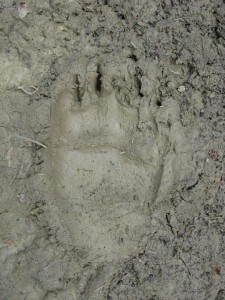 Iwo, a 5-year old bear collared in Poland, went from the Tatra Mountains through the whole Slovakia to Hungary in one week.
Iwo, a 5-year old bear collared in Poland, went from the Tatra Mountains through the whole Slovakia to Hungary in one week.
Iwo was captured and collared in the Polish Tatras by researchers of the Tatra National Park and the Institute of Nature Conservation in Krakow a year ago. Since then, his collar takes his position with a GPS at time intervals and send them via SMS to a computer. This way, researchers can gain understanding of the movements, space needs and food habits of this secret species for better protection. Iwo’s collar is programmed to drop-off in one year.
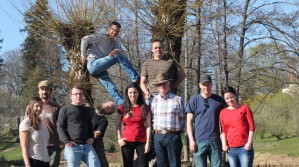 The third GLOBE meeting was held in Ås by the University Campus on 20-24th April 2015. During the meeting we had the opportunity to get to know some of the preliminary results that were presented and to discuss further issues related to the stress and stable isotope analyses of samples as well as modelling of climate and human impacts. This is the first meeting with all GLOBE post-doctoral researchers on board. Now GLOBE is right in the middle of its developments. This meeting has been a productive and inspiring one.
The third GLOBE meeting was held in Ås by the University Campus on 20-24th April 2015. During the meeting we had the opportunity to get to know some of the preliminary results that were presented and to discuss further issues related to the stress and stable isotope analyses of samples as well as modelling of climate and human impacts. This is the first meeting with all GLOBE post-doctoral researchers on board. Now GLOBE is right in the middle of its developments. This meeting has been a productive and inspiring one.
Photo by Agnieszka Sergiel
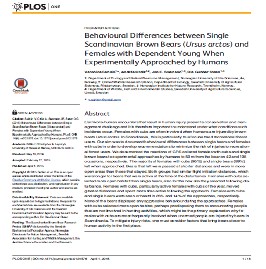 Female brown bears with young have a reputation for being more aggressive than solitary bears. Veronica Sahlén and co-authors have just published in PLoS One the results of their investigations on the response of females with cubs versus other bears when approached by humans. The authors conducted 107 experimental approaches of GPS-GSM collared bears. The majority of females with cubs (95%) and single bears (89%) left when approached. They found that none of the bears displayed any aggressive behavior and that females with young were not more aggressively defending their offspring. Bear-human encounters are rare and in Scandinavia. No fatalities involving females with cubs have occurred in the last 100 years. Making noise and talking, particularly when entering patches of dense vegetation, where bears usually rest during the day, is the best way to avoid encounters.
Female brown bears with young have a reputation for being more aggressive than solitary bears. Veronica Sahlén and co-authors have just published in PLoS One the results of their investigations on the response of females with cubs versus other bears when approached by humans. The authors conducted 107 experimental approaches of GPS-GSM collared bears. The majority of females with cubs (95%) and single bears (89%) left when approached. They found that none of the bears displayed any aggressive behavior and that females with young were not more aggressively defending their offspring. Bear-human encounters are rare and in Scandinavia. No fatalities involving females with cubs have occurred in the last 100 years. Making noise and talking, particularly when entering patches of dense vegetation, where bears usually rest during the day, is the best way to avoid encounters.
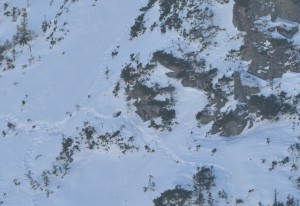

Just to remind, that while hiking in springtime in the Tatras and in the Bieszczady one can meet a bear awaken from the winter sleep. One should try to keep calm, try not to disturb the animal and go in the opposite direction.
Photo by Nuria Selva, Tomasz Zwijacz-Kozica
